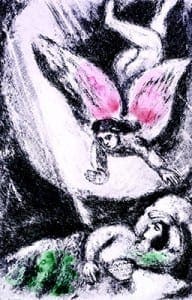Atlanta
Popes have extolled artists’ gifts to touch the human spirit
By NICHOLE GOLDEN, Staff Writer | Published October 24, 2013
ATLANTA—North Georgia artist Josef Mahler’s many works have included paintings, drawings and woodcarvings of scenes ranging from the Nativity to the Stations of the Cross.
Mahler has demonstrated his talents and shared his work in both Catholic churches and non-Catholic venues such as the Sautee Nacoochee Center Association art galleries exhibit of Amazing(ly) Grace(ful) in 2010.

This etching titled “Solomon’s Dream” is by artist Marc Chagall. Chagall, whose biblical art was praised by Pope Benedict XVI, called the Bible “the greatest source of poetry of all time.” CNS Photo
Part of Mahler’s goal in creating art, an endeavor he began at the age of 12 in his native Germany, was to help “bring the altar to the people.”
From Rome, the popes have often discussed the role of art and addressed artists gathering at the Vatican and also by apostolic letter.
Pope Paul VI met with a group of art students from the Istituto Pio XII of Florence in 1973.
“The Second Vatican Council has spoken to us about the dignity of art. In the Constitution on the Sacred Liturgy we are given this assurance: ‘Very rightly the fine arts are considered to rank among the noblest expressions of human genius. This judgment applies especially to religious art and to its highest achievement, which is sacred art’,” said the Holy Father in his greeting.
Pope Paul VI continued saying that he hoped the students would find inspiration in the great themes of the Christian faith seen all around them. “May you be able to render authentic service to your fellowmen by helping them to lift up their hearts to the Father of us all, from whom comes every good and perfect gift,” he said.
Pope John Paul II’s Letter to Artists was distributed on Easter Sunday 1999. In the letter, the pope discussed the special vocation of the artist, and art and the mystery of the Word made flesh.
“From the Nativity to Golgotha, from the Transfiguration to the Resurrection, from the miracles to the teachings of Christ, and on to the events recounted in the Acts of the Apostles or foreseen by the Apocalypse in an eschatological key, on countless occasions the biblical word has become image, music and poetry, evoking the mystery of ‘the Word made flesh’ in the language of art,” wrote Pope John Paul II.
True artists, he wrote, are ready to acknowledge their limits. The Holy Father also outlined why the church needs art and why art needs the church.
“Art has a unique capacity to take one or other facet of the message and translate it into colours, shapes and sounds which nourish the intuition of those who look or listen. It does so without emptying the message itself of its transcendent value and its aura of mystery.”
Pope John Paul told artists that Christianity offers a horizon especially rich in inspiration.
“What an impoverishment it would be for art to abandon the inexhaustible mine of the Gospel,” he wrote. “May you be guided and inspired by the mystery of the Risen Christ, whom the Church in these days contemplates with joy.”
Almost 10 years later, Pope Benedict XVI recalled his predecessor’s proclamation of Blessed Fra Angelico as the patron of artists, presenting him as the “perfect harmony between faith and art.” The pope made his 2009 remarks while meeting with artists in the Sistine Chapel.
Blessed Fra Angelico was a Dominican painter, and the Incarnation was one of his favorite themes.
Much of Pope Benedict’s address focused on beauty in art and the path of beauty being an artistic and aesthetic journey of both faith and theological inquiry.
“You are the custodians of beauty: thanks to your talent, you have the opportunity to speak to the heart of humanity, to touch individual and collective sensibilities, to call forth dreams and hopes, to broaden the horizons of knowledge and of human engagement. Be grateful, then, for the gifts you have received and be fully conscious of your great responsibility to communicate beauty, to communicate in and through beauty! Through your art, you yourselves are to be heralds and witnesses of hope for humanity! And do not be afraid to approach the first and last source of beauty, to enter into dialogue with believers, with those who, like yourselves, consider that they are pilgrims in this world and in history towards infinite Beauty,” he said.
“Faith takes nothing away from your genius or your art: on the contrary, it exalts them and nourishes them, it encourages them to cross the threshold and to contemplate with fascination and emotion the ultimate and definitive goal, the sun that does not set, the sun that illumines this present moment and makes it beautiful,” Pope Benedict said.